Modelling of Guillotine Cutting of a Cold-Rolled Steel Sheet
Abstract
1. Introduction
2. State of the Art
3. Methodology
- Elaboration of a physical model of a cutting process;
- Adopting the mathematical model that corresponds to the mentioned physical model;
- Application of Columb and Moren’s friction model;
- Assumption of the material model and mechanical properties;
- Application of appropriate boundary conditions in loads and displacements;
- The finite element method and the computer system LS-DYNA (LSTC, Livermore, CA, USA) were used to model the cutting process;
- Experimental investigations based on observations of the microstructure of cross-sections of surfaces being cut using a scanning electron microscope with a cold field emission (FESEM) HITACHI S-4700 (Hitachi, Ltd., Tokyo, Japan) equipped with the energy dispersive X-ray (EDS) NORAN Vantage spectrometer (Noran Co, Vernon, CA, USA) were conducted;
- Comparison of gathered experimental data with the results of numerical simulations in order to verify the correctness of the assumed physical model was carried out.
3.1. Physical Model of the Sheet Being Cut
- (1)
- Is it possible to observe any geometrical and physical differences in the plate being cut that can be modelled as deformable during the cutting process?
- (2)
- In case differences occur, what is the quantitative and qualitative nature of these differences?
- (3)
- What does an equivalent Huber–Mises stress and strain distribution during the cutting process look like?
- (4)
- How large are the plastic and brittle zones formed during cutting?
- (5)
- Are the changes significant enough to prepare the optimization of the cutting process, taking into consideration the shape geometry of the blade of a cutting tool, in order to improve the quality of the surfaces of the plates being cut, which is understood as minimization of the size of the plastic zone, in the future?
- (1)
- Preparation of the geometry of a symmetrical cutting tool;
- (2)
- Elaboration of the geometry of a plate being cut (together with the remained pressure beam and worktable);
- (3)
- Admission of the assumption of a physical material model;
- (4)
- Assumption of rectilinear velocity for the cutting tool, resulting from the experimental investigation;
- (5)
- Take into consideration the boundary conditions;
- (6)
- Preparation of the physical model of a cutting process;
- (7)
- Elaboration of the mathematical model based on the physical model;
- (8)
- Execution of the numerical computations using the LS-DYNA computer system;
- (9)
- Analysis and physical interpretations of the gained numerical results;
- (10)
- Preparation of the experimental investigations using a scanning electron microscope;
- (11)
- Analysis and physical interpretations of the gained experimental results;
- (12)
- Comparison of the numerical and experimental results;
- (13)
- Conclusions.
- The blade of a cutting tool and the plate being cut;
- The blade of a cutting tool and the worktable;
- The pressure beam and the plate being cut;
- The plate being cut and the worktable.
3.2. Material
4. Results and Discussion
4.1. Numerical Simulations
- In the first step, the pressure beam compresses the sheet;
- In the second step, the cutting tool moves in order to cut off the sheet.
- The first one is connected with a gradual smooth starting-up motion from the original position downwards until the pressure beam attains a maximum rectilinear velocity;
- The second one concerns the rectilinear motion, with a maximum constant velocity (12 mm/s) until it reaches certain a priori defined conditions;
- The third is tied with a deceleration of the pressure beam, which moves towards the ultra-thin plate being cut.
4.2. Microscopic Observations
4.3. Comparison of the Numerical and Experimental Results
5. Conclusions
- The stresses and strains are symmetrically distributed with respect to the vertical line passing through the tip of the blade of the cutting tool;
- The equivalent Huber–Mises stress and strain distributions during cutting are different at the beginning and at the end of the cutting process. At the beginning of the cutting process, the stress and strain are concentrated in the direct cutting zone, which comes from shearing and results in ductile cracking. At the end of the cutting process, the shearing ceases to act and the tension starts to dominate, resulting in the occurrence of a brittle fracture, the mechanism of which is similar to the cracking during the uniaxial tensile test;
- The surfaces of the sheet being cut are divided into two characteristic zones:
- ○
- The first one (undesired) is connected with the plastic fracture accompanied by many defects, such as edge bending, scratches in the shape of vertical craters, burrs, etc.;
- ○
- The second one (highly desired) concerns brittle fracture with no defects. The surfaces are characterized by high smoothness and low roughness, without vertical scratches or burrs;
- The comparison concerning the numerical results and experimental ones provides evidence that the border between the plastic fracture and brittle crack exists and can be determined;
- The plastic and brittle fracture depends on the cutting process and on the material being cut too, however, these two effects were taken into consideration simultaneously in the numerical simulations and experimental investigations. Within the limited range of velocities of the cutting tool, varying up to 10 mm/s, the following two conclusions might be drawn:
- ○
- The plastic zone occupies circa 1/5 of the height of the sheet being cut measured from the top downwards and hence, edge bending, vertical scratches, and burrs occur in this particular area;
- ○
- The brittle zone encompasses circa 4/5 of the height of the sheet being cut measured from the bottom upwards and that is why there are no defects, such as edge bending, vertical scratches, and burrs, in this specific region.
Funding
Acknowledgments
Conflicts of Interest
References
- Show, M.C. Metal Cutting Principles; Oxford University Press: New York, NY, USA, 2005. [Google Scholar]
- Callister, W.D. Fundamentals of Materials Science and Engineering; Von Hoffmann Press: New York, NY, USA, 2001. [Google Scholar]
- Duda, S.; Kciuk, S.; Gniłka, J.; Kaszyca, T. Numerical investigations of the influence of seismic vibrations on the transformer structure. In Proceedings of the 14th International Scientific Conference: Computer Aided Engineering; CAE 2018, Wrocław, Poland, 22–23 June 2018; Rusiński, E., Pietrusiak, D., Eds.; Springer: Cham, Switzerland, 2019; pp. 163–174. [Google Scholar] [CrossRef]
- Weresa, E.; Seweryn, A.; Szusta, J.; Rak, Z. Fatigue testing of transmission gear. Maint. Reliabil. 2015, 17, 2. [Google Scholar] [CrossRef][Green Version]
- Singh, G.; Pruncu, C.I.; Gupta, M.K.; Mia, M.; Khan, A.M.; Jamil, M.; Pimenov, D.Y.; Sen, B.; Sharma, V.S. Investigations of machining characteristics in the upgraded MQL-assisted turning of pure titanium alloys using evolutionary algorithms. Materials 2019, 12, 999. [Google Scholar] [CrossRef] [PubMed]
- García Nieto, P.J.; García-Gonzalo, E.; Ordóñez Galán, C.; Sánchez, A.B. Hybrid ABC optimized MARS-based modeling of the milling tool wear from milling run experimental data. Materials 2016, 9, 82. [Google Scholar] [CrossRef] [PubMed]
- Zhu, Z.; Cao, P.; Guo, X.; Wang, X.A.; Zhang, F.; Gao, Y. Machinability of luxury vinyl tiles during plain milling using a helical cutter. Materials 2019, 12, 2174. [Google Scholar] [CrossRef]
- Liu, H.; Zhang, J.; Xu, X.; Qi, Y.; Liu, Z.; Zhao, W. Effects of dislocation density evolution on mechanical behavior of OFHC copper during high-speed machining. Materials 2019, 12, 2348. [Google Scholar] [CrossRef]
- Olufayo, O.A.; Che, H.; Songmene, V.; Katsari, Ch.; Yue, S. Machinability of rene 65 superalloy. Materials 2019, 12, 2034. [Google Scholar] [CrossRef]
- Machno, M. Impact of process parameters on the quality of deep holes drilled in inconel 718 using EDD. Materials 2019, 12, 2298. [Google Scholar] [CrossRef]
- Sharif Ullah, A.M.M.; Caggiano, A.; Kubo, A.; Chowdhury, M.A.K. Elucidating grinding mechanism by theoretical and experimental investigations. Materials 2018, 11, 274. [Google Scholar] [CrossRef]
- Kaczmarczyk, J.; Grajcar, A. Numerical simulation and experimental investigation of cold-rolled steel cutting. Materials 2018, 11, 1263. [Google Scholar] [CrossRef]
- Kaczmarczyk, J.; Kozłowska, A.; Grajcar, A.; Sławski, S. Modelling and microstructural aspects of ultra-thin sheet metal bundle cutting. Metals 2019, 9, 162. [Google Scholar] [CrossRef]
- Bohdal, Ł. Application of a SPH Coupled FEM method for simulation of trimming of aluminum autobody sheet. Acta Mech. Autom. 2016, 10, 56–61. [Google Scholar] [CrossRef]
- Gasiorek, D.; Baranowski, P.; Malachowski, J.; Mazurkiewicz, L.; Wiercigroch, M. Modelling of guillotine cutting of multi-layered aluminum sheets. J. Manuf. Process. 2018, 34, 374–388. [Google Scholar] [CrossRef]
- Kaczmarczyk, J. Numerical simulations of preliminary state of stress in bundles of metal sheets on the guillotine. Arch. Mater. Sci. Eng. 2017, 85, 14–23. [Google Scholar] [CrossRef]
- Kaczmarczyk, J.; Gąsiorek, D.; Mężyk, A.; Skibniewski, A. Connection between the defect shape and stresses which cause it in the bundle of sheets being cut on guillotines. Model. Optim. Phys. Syst. 2007, 6, 81–84. [Google Scholar]
- Kaczmarczyk, J. Force Measurement in the Guillotine Tool of a Prototypical Guillotine. In Depth-Solutions with Graphical System Design in Eastern Europe; National Instruments: Warszawa, Poland, 2012; pp. 63–65. [Google Scholar]
- Fedeliński, P.; Górski, R.; Czyż, T.; Dziatkiewicz, G.; Ptaszny, J. Analysis of effective properties of materials by using the boundary element method. Arch. Mech. 2017, 66, 19–35. [Google Scholar]
- Fedeliński, P. Dynamically loaded branched and intersecting cracks. J. Civ. Eng. 2017, 34, 17–26. [Google Scholar] [CrossRef][Green Version]
- Paggi, M. Crack propagation in honeycomb cellular materials: A computational approach. Metals 2012, 2, 65–78. [Google Scholar] [CrossRef]
- Cho, J.R. A numerical evaluation of SIFs of 2-D functionally graded materials by enriched natural element method. Appl. Sci. 2019, 9, 3581. [Google Scholar] [CrossRef]
- Perez, N. Fracture Mechanics; Kluwer Academic Publishers: Boston, MA, USA, 2004. [Google Scholar]
- Flizikowski, J.; Kruszelnicka, W.; Tomporowski, A.; Mroziński, A. A study of operating parameters of a roller mill with a new design. In AIP Conference Proceedings; AIP Publishing: Melville, NY, USA, 2019; Volume 2077. [Google Scholar]
- Wróbel, G.; Szymiczek, M.; Kaczmarczyk, J. Influence of the structure and number of reinforcement layers on the stress state in the shells of tanks and pressure pipes. Mech. Compos. Mater. 2017, 53, 165–178. [Google Scholar] [CrossRef]
- Bathe, K.J.; Chaudhary, A. A solution method for planar and axisymmetric contact problems. Int. J. Numer. Method Eng. 1985, 21, 65–88. [Google Scholar] [CrossRef]
- Belytschko, T.; Liu, W.K.; Moran, B.; Elkhodary, K.I. Nonlinear Finite Elements for Continua and Structure; John Wiley & Sons, Ltd.: Southern Gate, CA, USA, 2014. [Google Scholar]
- Mohammadi, S. Discontinuum Mechanics Using Finite and Discrete Elements; WIT Press Southampton: Boston, MA, USA, 2003. [Google Scholar]
- Hughes, T.J.R. The Finite Element Method. Linear Static and Dynamic Finite Element Analysis; Manufactured in the United States by RR Donnelley: Chicago, IL, USA, 2016. [Google Scholar]
- Zienkiewicz, O.C.; Taylor, R.L. The Finite Element Method, Solid Mechanics; Butterworth-Heinemann: Oxford, UK, 2000. [Google Scholar]
- Xiong, X.; Xiao, Q. Meso-scale simulation of concrete based on fracture and interaction behavior. Appl. Sci. 2019, 9, 2986. [Google Scholar] [CrossRef]
- Nouari, M.; Makich, H. On the physics of machining titanium alloys: Interactions between cutting parameters, microstructure and tool wear. Metals 2014, 4, 335–338. [Google Scholar] [CrossRef]
- Razak, N.H.; Chen, Z.W.; Pasang, T. Effects of increasing feed rate on tool deterioration and cutting force during and end milling of 718plus superalloy using cemented tungsten carbide tool. Metals 2017, 7, 441. [Google Scholar] [CrossRef]
- Koklu, U.; Basmaci, G. Evaluation of tool path strategy and cooling condition effects on the cutting force and surface quality in micromilling operations. Metals 2017, 7, 426. [Google Scholar] [CrossRef]
- Haddag, B.; Atlati, S.; Nouari, M.; Moufki, A. Dry machining aeronautical aluminum alloy AA2024-T351: Analysis of cutting forces, chip segmentation and built-up edge formation. Metals 2016, 6, 197. [Google Scholar] [CrossRef]
- González, H.; Pereira, O.; Fernández-Valdivielso, A.; López de Lacalle, L.N.; Calleja, A. Comparison of flank super abrasive machining vs. flank milling on inconel® 718 Surfaces. Materials 2018, 11, 1638. [Google Scholar]
- Del Pozo, D.; López de Lacalle, L.N.; López, J.M.; Hernández, A. Prediction of press/die deformation for an accurate manufacturing of drawing dies. Int. J. Adv. Manuf. Technol. 2008, 37, 649–656. [Google Scholar] [CrossRef]
- Lamikiz, A.; López de Lacalle, L.N.; Sanchez, J.A.; Bravo, U. Calculation of the specific cutting coefficients and geometrical aspects in sculptured surface machining. Mach. Sci. Technol. 2005, 9, 411–436. [Google Scholar] [CrossRef]
- Timoshenko, S.P.; Goodier, J.N. Theory of Elasticity; McGraw-Hill Education: New York, NY, USA, 2017. [Google Scholar]
- Macko, M.; Flizikowski, J.; Szczepański, Z.; Tyszczuk, K.; Śmigielski, G.; Mroziński, A.; Czerniak, J.; Tomporowski, A. CAD/CAE applications in mill’s design and investigation. In Proceedings of the 13th International Scientific Conference: Computer Aided Engineering, Polanica Zdróój, Poland, 22–25 June 2016; Rusiński, E., Pietrusiak, D., Eds.; Springer: Cham, Switzerland, 2017; pp. 343–351. [Google Scholar]
- Bhatti, M.A. Practical Optimization Methods; Springer: New York, NY, USA, 2000. [Google Scholar]
- Rothwell, A. Optimisation Methods in Structural Design; Springer International Publishing AG: Delft, The Netherlands, 2017. [Google Scholar]
- Goldberg, D.E. Genetic Algorithms in Search, Optimization, and Machine Learning; Addison-Wesley Publishing Company, Inc.: New York, NY, USA, 1989. [Google Scholar]
- Michalewicz, Z. Genetic Algorithms + Data Structures = Evolution Programs; Springer: Berlin/Heidelberg, Germany, 1996. [Google Scholar]
- Arslanov, M.Z. A polynomial algorithm for one problem of guillotine cutting. Oper. Res. Lett. 2007, 35, 636–644. [Google Scholar] [CrossRef]
- Alvarez-Valdes, R.; Parajon, A.; Tamarit, J.M. A tabu search algorithm for large-scale guillotine (un)constrained two-d imensional cutting problems. Comput. Oper. Res. 2002, 29, 925–947. [Google Scholar] [CrossRef]
- Tiwari, S.; Chakraborti, N. Multi-objective optimization of a two-dimensional cutting problem using genetic algorithms. J. Mater. Process. Technol. 2006, 173, 384–393. [Google Scholar] [CrossRef]
- Beer, F.P.; Jonhston, E.R. Vector Mechanics for Engineers; Mc Graw-Hill Book Company: New York, NY, USA, 1984. [Google Scholar]
- Livermore Software Technology Corporation. LS-DYNA Keyword User’s Manual; Livermore Software Technology Corporation: Livermore, CA, USA, 2017. [Google Scholar]
- ASM International. ASM Handbook. Volume 12: Fractography; ASM International: Cleveland, OH, USA, 1987. [Google Scholar]



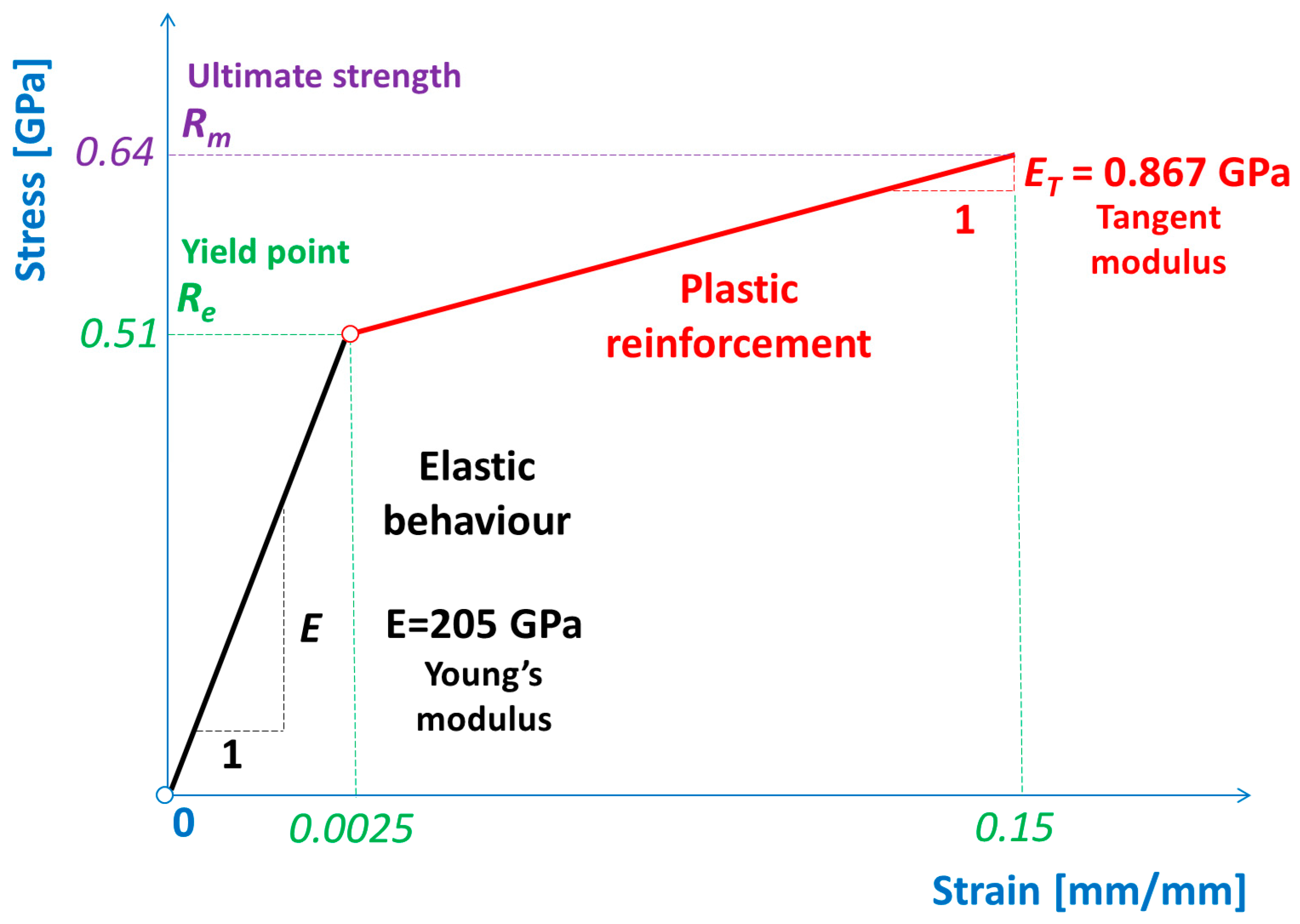
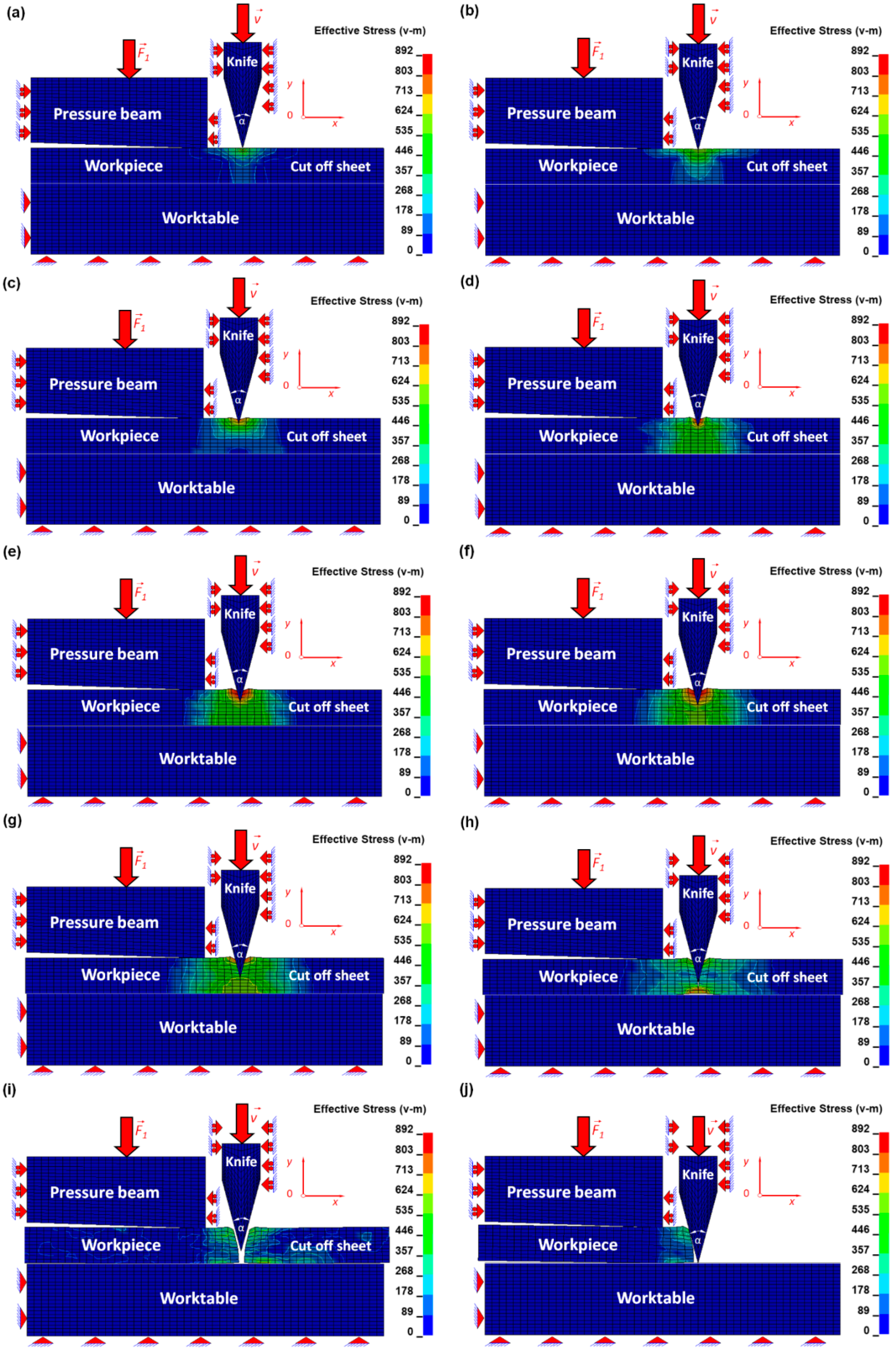


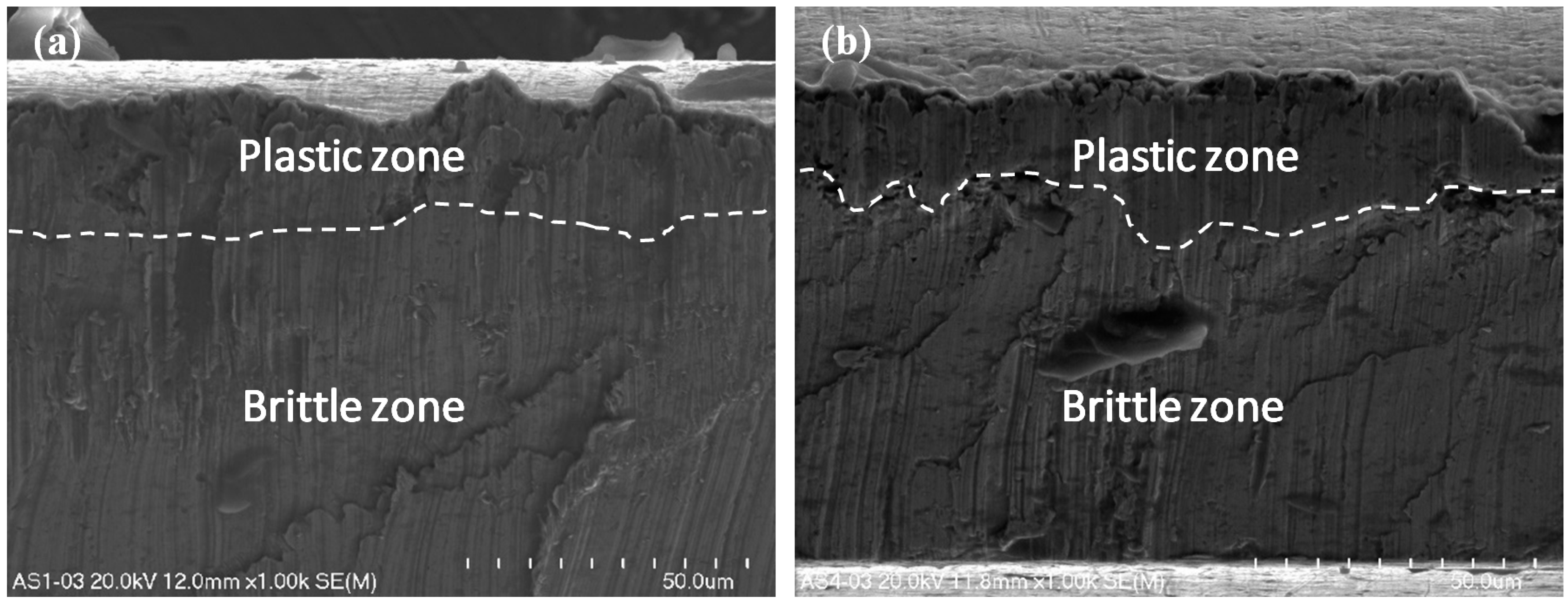
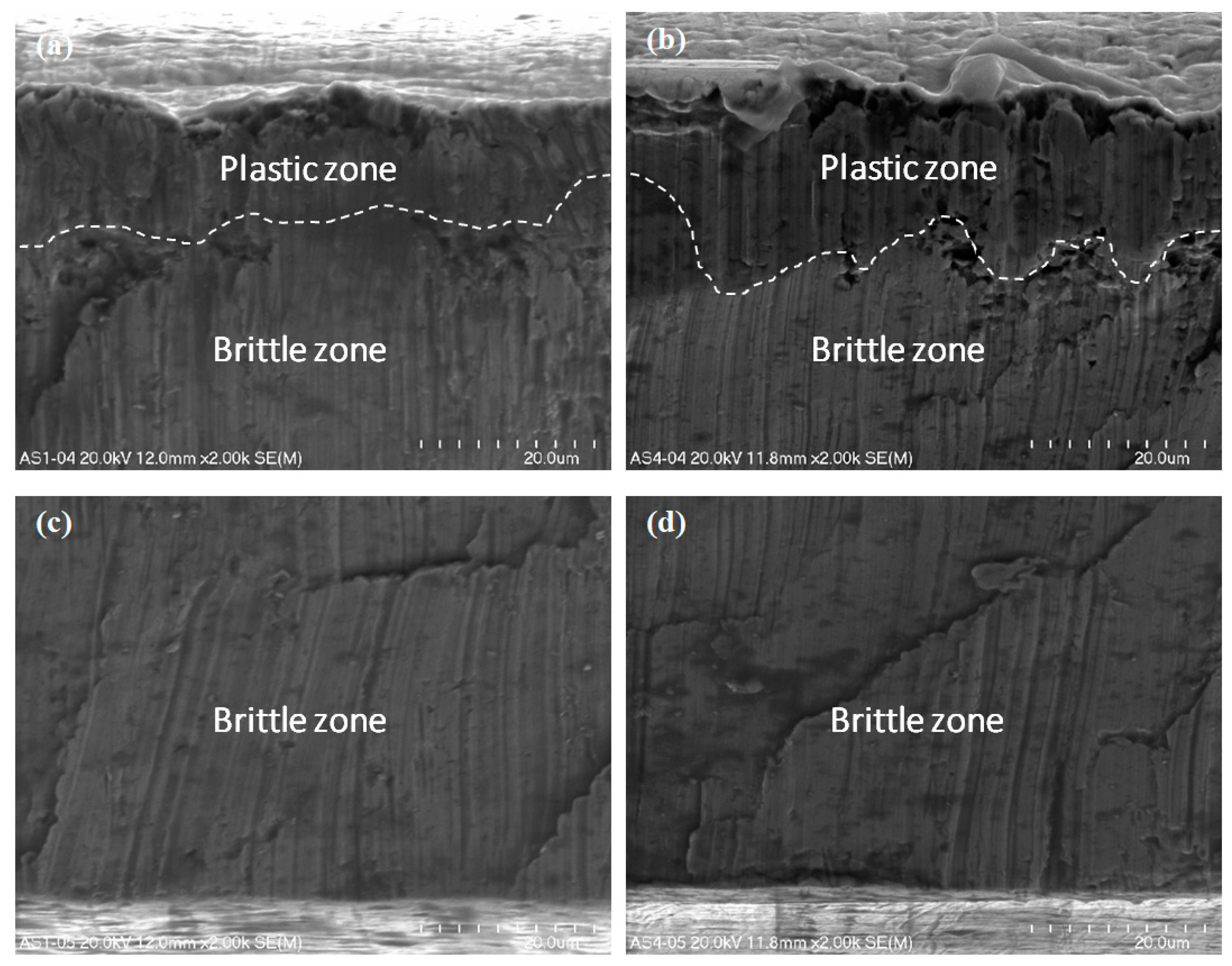
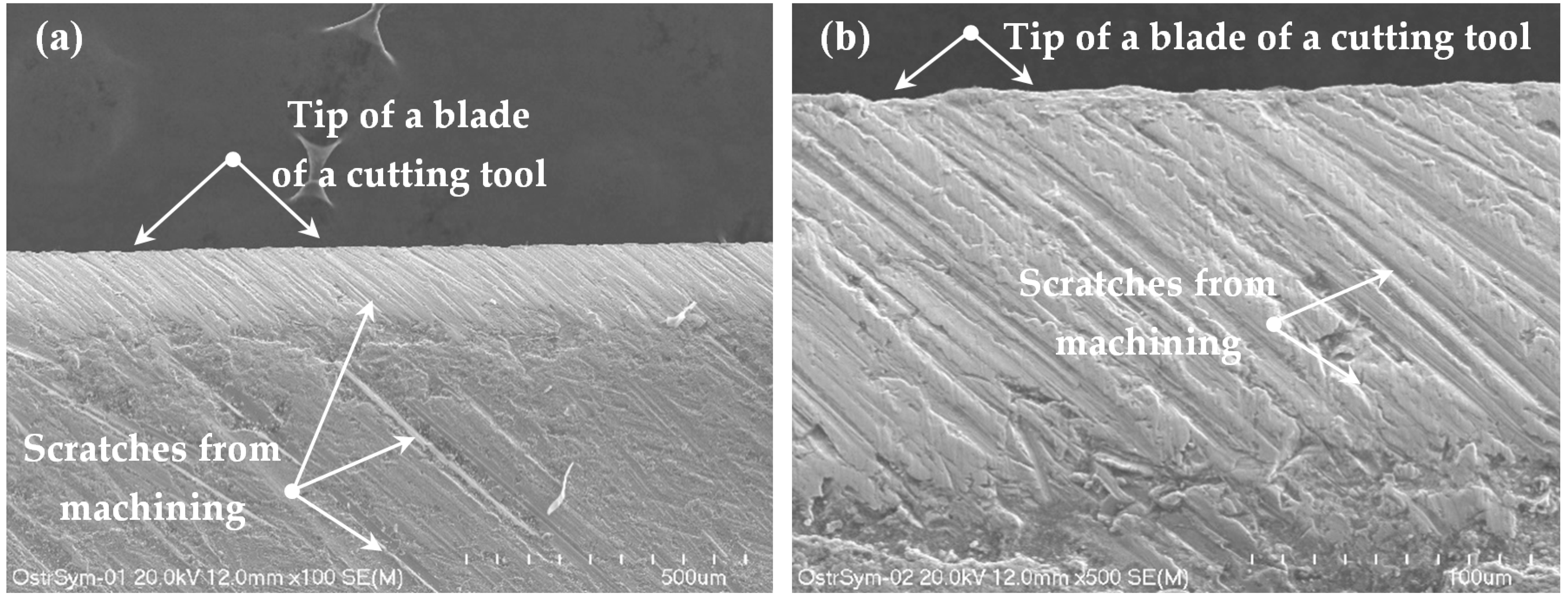
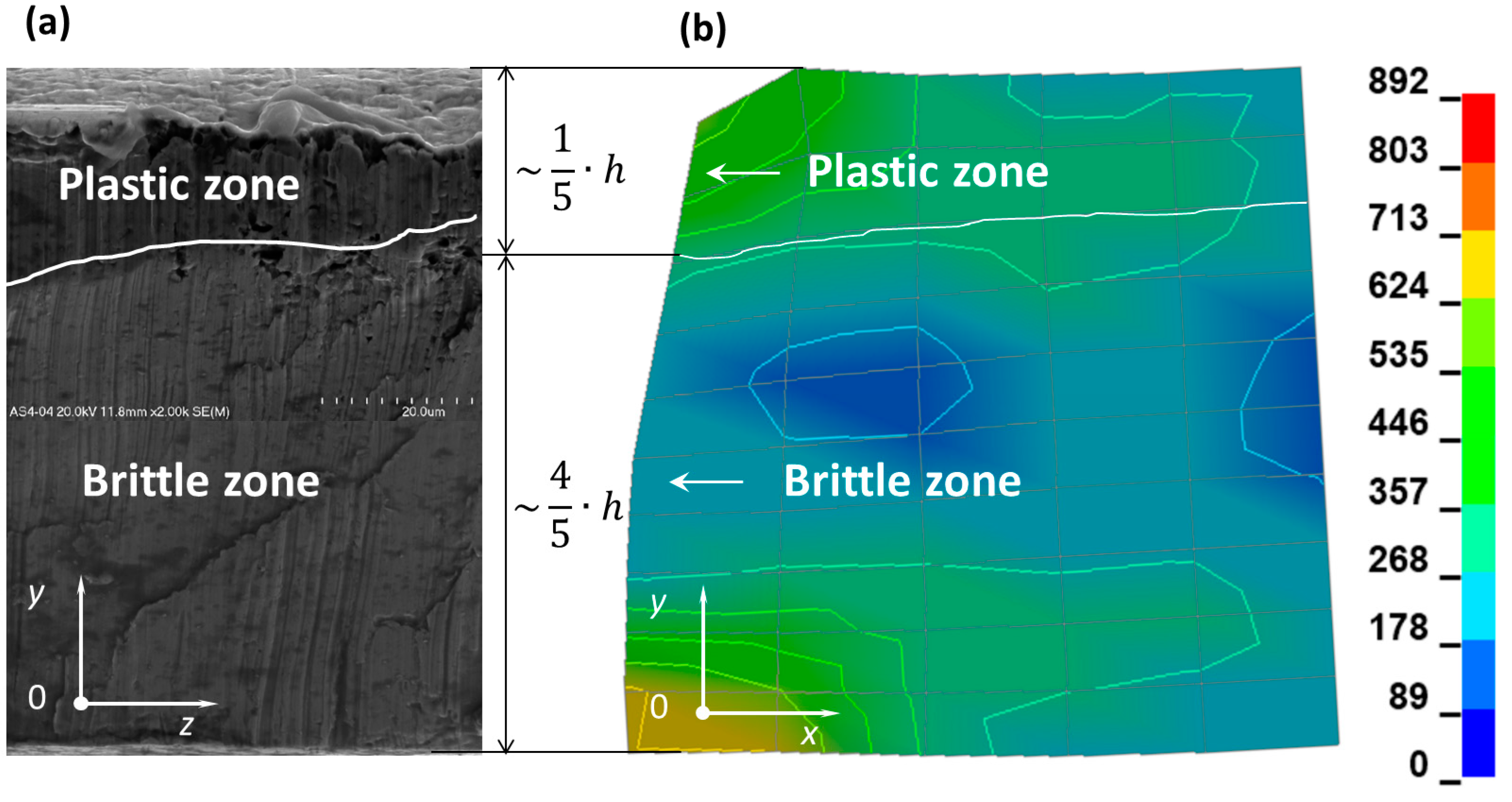

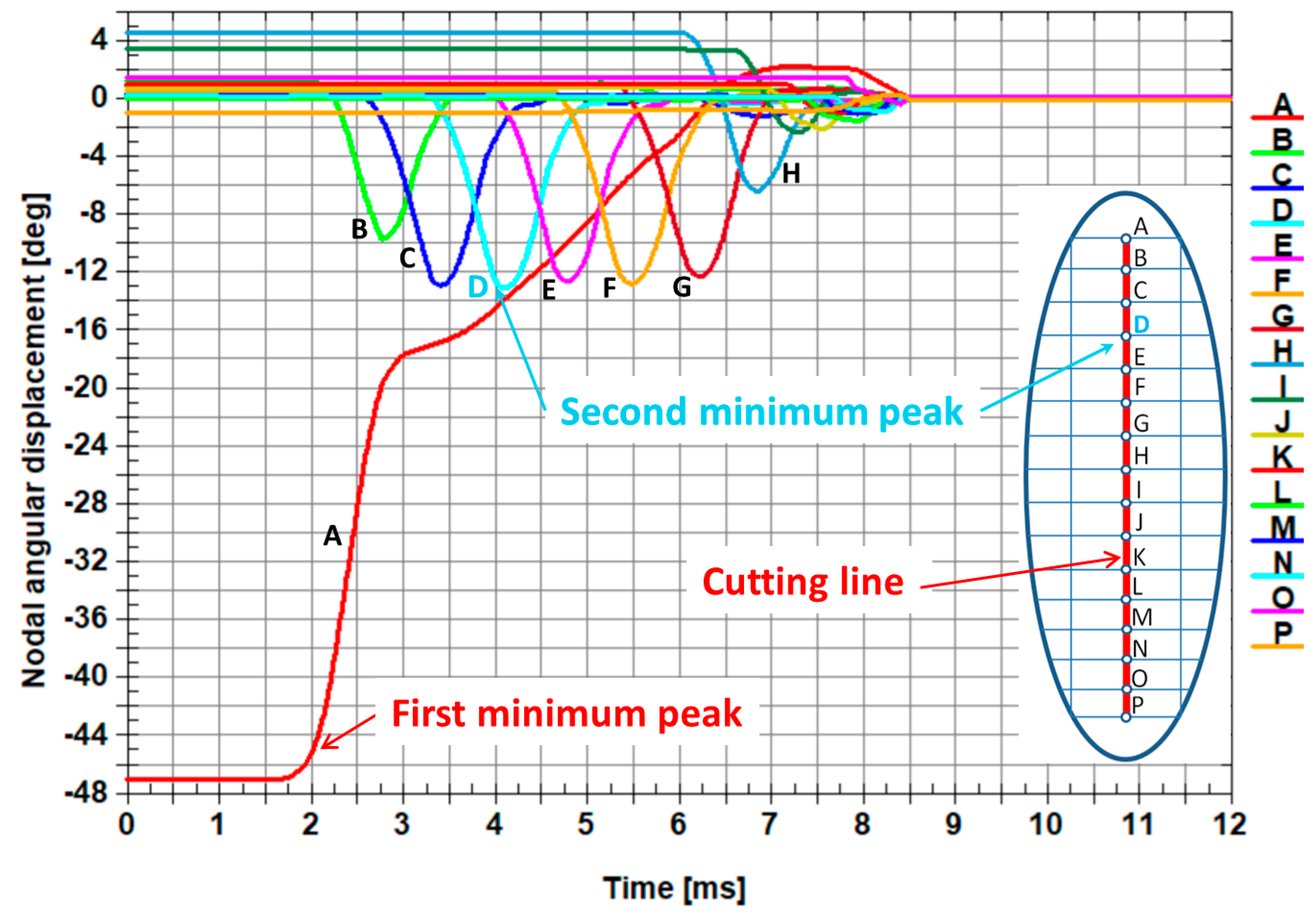
| No | Name of the Material Properties | Symbol | Value [2,12,13] |
|---|---|---|---|
| 1 | Young’s modulus | E | 205 GPa |
| 2 | Poison’s ratio | ν | 0.28 |
| 3 | Kirchhoff’s modulus | G | 80 GPa |
| 4 | Tangent modulus | ET | 0.867 GPa |
| 5 | Failure strain | ɛf | 0.15 |
| 6 | Yield stress | Re | 0.51 GPa |
| 7 | Ultimate tensile strength | Rm | 0.64 GPa |
© 2019 by the author. Licensee MDPI, Basel, Switzerland. This article is an open access article distributed under the terms and conditions of the Creative Commons Attribution (CC BY) license (http://creativecommons.org/licenses/by/4.0/).
Share and Cite
Kaczmarczyk, J. Modelling of Guillotine Cutting of a Cold-Rolled Steel Sheet. Materials 2019, 12, 2954. https://doi.org/10.3390/ma12182954
Kaczmarczyk J. Modelling of Guillotine Cutting of a Cold-Rolled Steel Sheet. Materials. 2019; 12(18):2954. https://doi.org/10.3390/ma12182954
Chicago/Turabian StyleKaczmarczyk, Jarosław. 2019. "Modelling of Guillotine Cutting of a Cold-Rolled Steel Sheet" Materials 12, no. 18: 2954. https://doi.org/10.3390/ma12182954
APA StyleKaczmarczyk, J. (2019). Modelling of Guillotine Cutting of a Cold-Rolled Steel Sheet. Materials, 12(18), 2954. https://doi.org/10.3390/ma12182954





